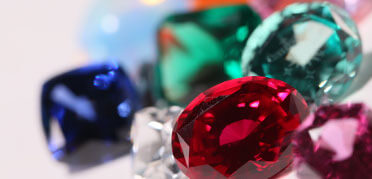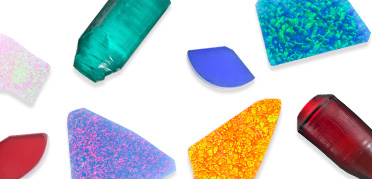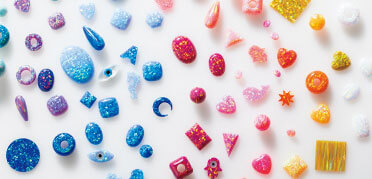News & Events
-
2025.9.11NEWSDiscover our new violet sapphire collection at the Hong Kong International Jewellery Show 2025, September 17–21.
Visit us at Booth 3M305. [More details (PDF/720KB)] -
2025.6.17NEWSKyocera will exhibit at the Hong Kong International Jewellery Show 2025, June 19–22 at the Convention & Exhibition Centre.
Visit us at Booth 1A326. [More details (PDF/1,289KB)] -
2025.6.4NEWSKyocera is delighted to announce our participation in JCK Las Vegas 2025, from June 6 to June 9, 2025.
Visit us at Booth No.4135 at The Venetian Expo [Click here for more details.(PDF/1,893KB)] -
2022.12.28NEWSWe will participate in BIJORHCA PARIS (International Jewellery Show) from 21st to 23rd Jan 2023.
Discover more here.(PDF/129KB)
Our Gemstones
- Seeking Perfection -
-
Emerald


Emerald

The deep green sparkle of emerald has mesmerized people since antiquity. The oldest of all jewels, emerald evokes comfort, creativity and bliss. Formed from beryl, alumina and silicic acid, the beautiful green color is produced by trace amounts of chrome within the gem. The world’s highest-grade emeralds come from a mine in Muzo, Colombia. Crescent Vert emerald compares favorably with gemstones from Muzo, exhibiting the same captivating color with blue undertones.
Available in sizes up to 1 carat.* If you need a larger stone, please contact us.View Comparison Table Item Crescent Vert Emerald Natural Emerald Chemical Composition 3BeO・Al2O3・6SiO2 3BeO・Al2O3・6SiO2 X-ray Diffraction Same as natural stone A pattern specific to Emerald Spectroscopic Analysis Same as natural stone Specific absorption of Emerald Crystal System Hexagonal Hexagonal Mohs Hardness 7.5~8.0 7.5~8.0 Specific Gravity 2.65~2.70 2.65~2.74 Melting Point 1410℃ 1410℃ Transparency Transparent Transparent ~ Translucent Refractive Index 1.563~1.568 1.565~1.598 Double Refraction 0.005 0.005~0.008 Average Dispersion 0.014 0.014 Pleochroism Green and Bluish green Green and Bluish green Chelsea Color Filter Examination Dark Red-Pink Dark Red-Pink -
Alexandrite


Alexandrite

Alexandrite reveals different colors under various lighting conditions. In the sun, it’s a deep blue-green. By candlelight, it looks purplish-red. Collectors covet this stone and its mysterious color signature, caused by trace amounts of chrome within the gem. Crescent Vert alexandrite possesses the same vivid color-changing properties as high-grade natural stones from Russia’s Ural Mountains.
Available in sizes up to 10 carats.* If you need a larger stone, please contact us.View Comparison Table Item Crescent Vert Alexandrite Natural Alexandrite Chemical Composition BeAl2O4 BeAl2O4 X-ray Diffraction Same as natural stone A pattern specific to Alexandrite Spectroscopic Analysis Same as natural stone Specific absorption of Alexandrite Crystal system Orthorhombic Orthorhombic Mohs Hardness 8.5 8.5 Specific Gravity 3.71 3.71~3.72 Melting Point 1870℃ 1870℃ Transparency Transparent Transparent Refractive Index 1.743~1.752 1.747~1.757 Double Refraction 0.009 0.01 Average Dispersion 0.015 0.015 Pleochroism (Daylight)
Bright bluish green, Pale yellow, Dark purplish red
(Incandescent light)
Bluish green, Pale yellow, Reddish purple(Daylight)
Bright green, Pale yellow, Red
(Incandescent light)
Bright green, Reddish yellow, RedChelsea Color Filter Examination Red Red -
Ruby


Ruby

The deep red color of ruby conjures passion and sensuality. Treasured since ancient times, ruby was used in amulets and secret medicines. Second only to diamond in hardness, ruby is made of corundum alumina. The finest natural rubies from Myanmar are called “pigeon blood” rubies, prized for their bright red, slightly purplish hue. Crescent Vert ruby is grown with care to radiate the enchanting crimson color and high transparency of natural stones.
Available in sizes up to 10 carats.* If you need a larger stone, please contact us.View Comparison Table Item Crescent Vert Ruby Natural Ruby Chemical Composition Al2O3 Al2O3 X-ray Diffraction Same as natural stone A pattern specific to Ruby Spectroscopic Analysis Same as natural stone Specific absorption of Ruby Crystal system Hexagonal Hexagonal Mohs Hardness 9 9 Specific Gravity 4.01 3.90~4.01 Melting Point 2050℃ 2050℃ Transparency Transparent Transparent Refractive Index 1.762~1.770 1.760~1.768 Double Refraction 0.008 0.008 Average Dispersion 0.018 0.018 Pleochroism Yellow-Red, Bright red Pale yellowish red, Pale red Chelsea Color Filter Examination Strong bright red Strong bright red -
Sapphire


Sapphire

While sapphire comes in many colors, deep blue sapphire is the most famous and the standard against which other blue gemstones are measured. This ancient gemstone is said to bring wisdom, protect the wearer from evil, and promote healing. Its bright blue sparkle has been loved for centuries as a symbol of the heavens and source of faithfulness and peace of mind.
Our Crescent Vert blue sapphire is highly valued for its cornflower blue color.Available in sizes up to 10 carats.* If you need a larger stone, please contact us.View Comparison Table Item Crescent Vert Blue Sapphire Natural Blue Sapphire Chemical Composition Al2O3 Al2O3 X-ray Diffraction Same as natural stone A pattern specific to Blue Sapphire Spectroscopic Analysis Same as natural stone Specific absorption of Blue Sapphire Crystal System Hexagonal Hexagonal Mohs Hardness 9 9 Specific Gravity 4.01 3.90 ~ 4.00 Melting Point 2050°C 2050°C Transparency Transparent Transparent Refractive Index 1.762 ~ 1.770 1.760 ~ 1.768 / 1.770 ~ 1.779 Double Refraction 0.008 0.008 ~ 0.010 Average Dispersion 0.018 0.018 Pleochroism Pale greenish blue/dark blue Pale greenish blue/dark blue Chelsea Color Filter Examination Unchanged Black green, Unchanged -
Padparadscha


Padparadscha

Called the King of Sapphires, padparadscha is found only in Sri Lanka. Its name means "the morning glow of the Indian Ocean." Padparadscha sapphire is a very rare gemstone. Its remarkable pinkish-orange color evokes dignity and mercy.
Padparadscha sapphire, blue sapphire and ruby all originate from a mineral called corundum. Only gemstones that achieve an aurora red color—a delicate balance between orange and pink—are worthy of being called Crescent Vert padparadscha.Available in sizes up to 10 carats.* If you need a larger stone, please contact us.View Comparison Table Item Crescent Vert Padparadscha Natural Padparadscha Chemical Composition Al2O3 Al2O3 X-ray Diffraction Same as natural stone A pattern specific to Padparadscha Spectroscopic Analysis Same as natural stone Specific absorption of Padparadscha Crystal system Hexagonal Hexagonal Mohs Hardness 9 9 Specific Gravity 4.01 3.90~4.01 Melting Point 2050℃ 2050℃ Transparency Transparent Transparent Refractive Index 1.762~1.770 1.760~1.768 Double Refraction 0.008 0.008 Average Dispersion 0.018 0.018 Pleochroism Orange, Pinkish orange, Yellowish orange Orange, Pinkish Orange, Yellowish orange Chelsea Color Filter Examination Red Red -
Green Chrysoberyl


Green Chrysoberyl

This gem’s name combines the Greek words chrysos (gold) and its chemical element Beryllos (shining gemstones). The popular gemstone is famous for its crisp green transparent sparkle. In Asia, chrysoberyl is believed to protect the wearer from evil. Crescent Vert green chrysoberyl features a refreshing bright green color with refined transparency.
Available in sizes up to 10 carats.* If you need a larger stone, please contact us.View Comparison Table Item Crescent Vert Green Chrysoberyl Natural Green Chrysoberyl Chemical Composition BeAl2O4 BeAl2O4 X-ray Diffraction Same as natural stone A pattern specific to Green Chrysoberyl Spectroscopic Analysis Same as natural stone Specific absorption of Green Chrysoberyl Crystal system Orthorhombic Orthorhombic Mohs Hardness 8.5 8.5 Specific Gravity 3.71 3.71 Melting Point 1870℃ 1870℃ Transparency Transparent Transparent Refractive Index 1.737~1.745 1.738~1.746 Double Refraction 0.008 0.008 Average Dispersion 0.015 0.015 Pleochroism Yellowish green, Green, Bluish green Yellow green, Green, Bluish green Chelsea Color Filter Examination Slight red Dark red -
Star Sapphire


Star Sapphire

The mysterious star sapphire is said to focus the mind with its three intersecting lines of light representing faith, hope and destiny. Star sapphire in a cabochon cut reveals needle-formed mineral inclusions that reflect the light and shine in asterism. Crescent Vert star sapphire, bright blue and full of dignity, displays distinctively beautiful starlight lines.
Available in sizes up to 10 carats.* If you need a larger stone, please contact us.View Comparison Table Item Crescent Vert Star Sapphire Natural Star Sapphire Chemical Composition Al2O3 Al2O3 X-ray Diffraction Same as natural stone A pattern specific to Star Sappfire Spectroscopic Analysis Same as natural stone Specific absorption of Star Sappfire Crystal system Hexagonal Hexagonal Mohs Hardness 9 9 Specific Gravity 4 3.98~4.06 Melting Point 2,050℃ 2,030~2,050℃ Transparency Transparent ~ Translucent Transparent ~ Translucent Refractive Index 1.762~1.770 1.762~1.770 Double Refraction 0.008 0.008~0.009 Average Dispersion 0.018 0.018 Pleochroism Dichroism (Greenish-blue, Dark blue) Dichroism (Greenish-blue, Dark blue) Chelsea Color Filter Examination Dark red Dark red - Unchanged -
Star Ruby


Star Ruby

Star ruby, in a cabochon cut, emits six distinct rays of light. These asterisms are named for the Greek word meaning “star.”
This mysterious phenomenon—starlight reflected inside the gemstone—is caused by trace needle-formed rutiles and corundum within the gem. Crescent Vert star ruby features a six-rayed star shimmering across the gem’s surface as it shines bright red and full of dignity.Available in sizes up to 10 carats.* If you need a larger stone, please contact us.View Comparison Table Item Crescent Vert Star Ruby Natural Star Ruby Chemical Composition Al2O3 Al2O3 X-ray Diffraction Same as natural stone A pattern specific to Star Ruby Spectroscopic Analysis Same as natural stone Specific absorption of Star Ruby Crystal system Hexagonal Hexagonal Mohs Hardness 9 9 Specific Gravity 4 3.90~4.01 Melting Point 2050℃ 2050℃ Transparency Transparent ~ Translucent Transparent ~ Translucent Refractive Index 1.762~1.770 1.762~1.770 Double Refraction 0.008 0.008 Average Dispersion 0.018 0.018 Pleochroism Yellowish red, Bright red Strong bright red -
White & Black Opal


White & Black Opal

White and black opal elicit a mysterious charm with their rich interplay of color. Engineered opal captures the essence of that beauty in shades of blue, green, red and purple swirled together in a dazzling display. Our engineered opals shine brightly, with each color expressing a different personal nuance. Opal’s colors result from light reflected through the stone’s silicon dioxide particles.
Kyocera’s proprietary process creates what nature cannot: Uniformly thick opal stones that won’t split or chip, making them ideal for intricate jewelry designs. Unlike natural opal, Crescent Vert opal and black opal can be easily and precisely cut, achieving what was once impossible in the jewelry world. In addition, Crescent Vert opal is incredibly durable, offering high heat resistance because of its well-balanced internal water content.Available in sizes up to 15 carats.* If you need a larger stone, please contact us.View Comparison Table White Opal Black Opal Item Crescent Vert Opal Natural Opal Crescent Vert Opal Natural Opal Chemical Composition SiO2・nH2O SiO2・nH2O SiO2・nH2O SiO2・nH2O X-ray Diffraction Amorphous Amorphous Amorphous Amorphous Spectroscopic Analysis Same as natural stone Specific absorption of Opal Same as natural stone Specific absorption of Black Opal Crystal system Amorphous Amorphous Amorphous Amorphous Mohs Hardness 5.0~6.5 5.5~6.5 5.0~6.5 5.5~6.5 Specific Gravity 1.90~2.23 1.90~2.20 1.95~2.20 1.98~2.20 Transparency Transparent ~ Translucent Transparent ~ Translucent Translucent ~ Opaque Translucent ~ Opaque Refractive Index 1.440~1.465 1.440~1.465 1.440~1.465 1.435~1.455 Ultraviolet Ray Examination (Long Wavelength)
Dark bluish violet - Inert
(Short Wavelength)
Pale blue - Inert(Long Wavelength)
Strong bluish white - Inert
(Short Wavelength)
Pale blue - Inert(Long Wavelength)
Dark bluish violet - Inert
(Short Wavelength)
Pale blue - Inert(Long Wavelength)
Strong bluish white - Inert
(Short Wavelength)
Pale bluish white - InertSpecial Effect Play of color Play of color Play of color Play of color -
Pink & Blue Opal


Pink & Blue Opal

Though white and black opals are more widely known, pink and blue opals are also popular colors of this versatile stone. In nature, pink and blue “common opals” display muted colors. Crescent Vert pink and blue opals are engineered with high transparency to showcase the vivid play-of-color within. Soft pink and refreshing blue iridescence remind us that opal symbolizes happiness.
Available in sizes up to 15 carats.* If you need a larger stone, please contact us.View Comparison Table Pink Opal Blue Opal Item Crescent Vert Opal Natural Opal Crescent Vert Opal Natural Opal Chemical Composition SiO2・nH2O SiO2・nH2O SiO2・nH2O SiO2・nH2O X-ray Diffraction Amorphous Amorphous Amorphous Amorphous Spectroscopic Analysis Same as natural stone Specific absorption of Opal Same as natural stone Specific absorption of Opal Crystal system Amorphous Amorphous Amorphous Amorphous Mohs Hardness 5.0~6.5 5.5~6.5 5.0~6.5 5.5~6.5 Specific Gravity 1.90~2.23 1.90~2.20 1.90~2.23 1.90~2.20 Transparency Transparent ~ Translucent Transparent ~ Translucent Translucent ~ Opaque Translucent ~ Opaque Refractive Index 1.440~1.465 1.440~1.465 1.440~1.465 1.440~1.465 Ultraviolet Ray Examination (Long Wavelength)
Dark bluish violet - Inert
(Short Wavelength)
Pale blue - Inert(Long Wavelength)
Strong bluish white - Inert
(Short Wavelength)
Pale blue - Inert(Long Wavelength)
Dark bluish violet - Inert
(Short Wavelength)
Pale blue - Inert(Long Wavelength)
Strong bluish white - Inert
(Short Wavelength)
Pale blue - InertSpecial Effect Play of color Play of color Play of color Play of color -
Fire Opal


Fire Opal

The fiery orange fire opal enchants by glowing as brightly as flames in a fire or the glittering Mexican sun.
With superior transparency and vivid play-of-color, fire opal is named for its burning color and the passion it inspires worldwide.
The beautiful flame of Crescent Vert fire opal was the eleventh gemstone created in Kyocera's lab. Its fine orange color and transparency merit the high praise this engineered gem receives.Available in sizes up to 15 carats.* If you need a larger stone, please contact us.View Comparison Table Item Crescent Vert Fire Opal Natural Fire Opal Chemical Composition SiO2・nH2O SiO2・nH2O X-ray Diffraction Amorphous Amorphous Spectroscopic Analysis Same as natural stone Specific absorption of Fire Opal Crystal system Amorphous Amorphous Mohs Hardness 5.0~6.5 5.0~6.5 Specific Gravity 1.95~2.23 1.90~2.20 Transparency Transparent ~ Translucent Transparent ~ Translucent Refractive Index 1.430~1.455 1.430~1.455 Ultraviolet Ray Examination (Long Wavelength)
Dark Blue Violet - Inert
(Short Wavelength)
Pale Blue - Inert(Long Wavelength)
Strong Blue White - Inert
(Short Wavelength)
Pale Blue - InertSpecial Effect Play of color Play of color
-
Gofun


Gofun
Gofun, a traditional Japanese color, is white with a slight yellow caste similar to mother of pearl. Since the 14th century, gofun has been made by crushing oyster shells from Japan’s Seto Inland Sea.
Kyoto Opal Gofun achieves a traditional mother of pearl color with majestic brilliance.
-
Kariyasu


Kariyasu
Kariyasu, a traditional Japanese color, is light greenish yellow. The name comes from the kariyasugusa plant used as a yellow dye since the 8th century. This is considered to be the oldest yellow color in existence.
Kyoto Opal Kariyasu is the same bright yellow cherished for centuries.
-
Sakurairo


Sakurairo
Sakura is a Japanese cherry blossom featuring pale, purplish-pink flowers. Iro means color in Japanese. The cherry blossom is the national flower of Japan, where sakurairo is the color of spring.
Kyoto Opal Sakurairo is the pale purplish pink loved by the people of Japan.
-
Jinzamomi


Jinzamomi
Jinzamomi, a traditional Japanese color, is yellowish red. The name comes from the Kikyouya Jinzaburo dye shop in Kyoto. By using sappanwood and madder to replace the more expensive safflower as the red dye ingredient, this dye shop discovered a new dye method and named its new color Jinzamomi. The beautiful color and accessible price of Jinzamomi makes it very popular.
Kyoto Opal Jinzamomi is the bright red color everyone loves.
-
Karakurenai


Karakurenai
Karakurenai, a traditional Japanese color, is a bright dark red. To achieve its intense color saturation, karakurenai cloth was dyed with safflower eight times over.
In ancient times, safflower was expensive and considered forbidden, so only high-ranking aristocrats could wear karakurenai clothing.
Kyoto Opal Karakurenai is the bright dark red once considered a forbidden color.
-
Nijiiro


Nijiiro
Niji is the Japanese word for rainbow, and iro means color.
In Japan, we express the seven colors of a rainbow as red, orange, yellow, green, blue, indigo and purple.
Kyoto Opal Nijiiro seems pink at first glance, but its delicate pink color and brilliant fire erupt in a dazzling array of colors under changing light conditions.
-
Kakitsubatairo


Kakitsubatairo
Kakitsubata is a Japanese plant with a regal purple flower, and iro means color.
Kakitsubata was once used as a dye to produce a grape color similar to red wine. Purple is considered a noble color because the dye ingredient is relatively rare.
Our technology lets the noble purple Kyoto Opal Kakitsubatairo appear on various fashions items around the world.
-
Asagiiro


Asagiiro
Asagi is the light blue-green color of a spring onion, and iro means color.
Its beautiful light blue-green color reminds us that Japan is blessed with abundant water resources. Loved for more than 1,000 years, this traditional Japanese color grew in popularity when the shogun's last samurai corps used it on their fashionable uniforms.
Kyoto Opal Asagiiro is a fresh, light blue-green that reminds us of Japanese nature and history.
-
Tsuyukusairo


Tsuyukusairo
Tsuyukusa is a popular plant with a light blue flower, and iro means color. Tsuyukusa is used in the traditional Yuzen dying technique in Kyoto, and is therefore a culturally significant color in Japan.
Kyoto Opal Tsuyukusairo forms a light blue bridge between the fashion world and Japanese culture.
-
ChitoseMidori


ChitoseMidori
ChitoseMidori, a traditional Japanese color, is dark green like Japanese pine.
The Japanese pine symbolizes longevity because pine trees are evergreen. ChitoseMidori means that the color won’t change, even after 1,000 years.
Kyoto Opal ChitoseMidori captures the immutable beauty of Japanese pine needles.
-
Ruriiro


Ruriiro
Ruri is Japanese for lapis lazuli, and iro means color.
Lapis lazuli is one of the seven treasures in Buddhism, making ruriiro a sacred color.
By fusing the color of lapis lazuli with brilliant fire, Kyoto Opal Ruriiro expresses the brilliance of a fiery night sky.
-
Momoshiocha


Momoshiocha
Momoshiocha is a traditional Japanese color similar to chocolate, but with complex undertones of brown, green and red that give it a brilliant luster.
By fusing the characteristically deep color with brilliant fire, Kyoto Opal Momoshiocha manifests a rich chocolate color of our dreams.
Our Values
- A pioneer in Japanese
lab-grown gemstones -

The rich hues and sparkling brilliance of our gemstones highlight the elegance of intricate jewelry
settings and designs.
Kyocera is a trusted gemstone provider for designers who dedicate their lives to creating beautiful
jewelry that brings joy to all who wear it.













































































